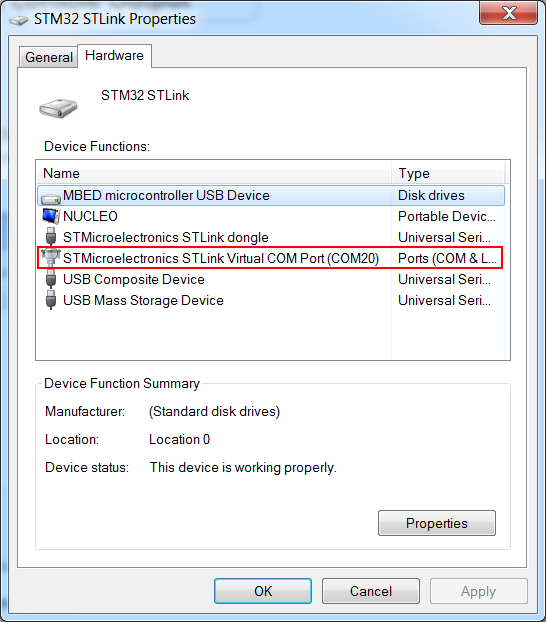
STM32 Virtual COM Port Driver 1.5.0. Redistributions in binary form, except as embedded into microcontroller or microprocessor device manufactured by or for STMicroelectronics or a software update for such device, must reproduce the above copyright notice, this list of conditions and the following disclaimer in the documentation and/or other. This core will allow you to use BSFrance AVR based boards with the Arduino ecosystem, it ibsed on STM32 HAL. At first drivers for the usb-serial (VCP, Virtual Com Port) and DFU (Device Firmware Upgrade) have to be installed. This applies to Windows only, Mac OSX and Linux users wont have to install drivers (in most cases).
MAC OS Driver (Virtual COM Port) for STM32 USB. Posted on April 27, 2016 at 11:41. Hi, Anyone knows how to use STM32 USB as virtual com port under MAC OS? Do ST provide official driver for this? Posted on April 29, 2016 at 08:21. MacOSX recognizes CDC(-ACM) devices (ie. Virtual COM port) without ANY extra driver. Just plug in the. Simply select the STM32 Bootloader device within the device manager, right click and select update driver software and follow the images below STM-DFU-Driver.jpg 1919×1393 275 KB That should solve any driver issues but if you still have any questions/problem let me know so we can try figure it out and add it to the guide.
Unable to Mount Virtual COM Port in Windows 10
If you are using Windows 10 (or any other operating system) and having problems getting a Virtual COM Port to be assigned to your system, follow these steps. We recently discovered after a Windows 10 Update, that Virtual COM Port drivers may not load any-longer by default for some devices. If you are unable to use Base Station or AnyI2C software because the COM port is not showing up, here’s an easy fix:
Prerequisite: VCP Driver Installation
Recent operating system updates, hardware (VCP Chip) revisions, and VCP drivers may prevent a Virtual COM Port from registering properly with your operating system. We have seen ALL THREE factors prevent proper operation. We STRONGLY ADVISE installation of the latest drivers for your particular operating system before going any further. NCD hardware uses FTDI drivers for most devices, you should download and install the latest FTDI drivers from here.
In most cases, this should resolve your virtual COM port registration problem and a new COM port should appear in “Device Manager”. If this does not mount the virtual COM port to your system, please follow the steps outlined below.
Step 1: Open Device Manager
Move your Mouse pointer to the lower left corner of the screen and type “Device Manager”. Click on the “Device Manager” as shown in Blue in the screenshot below.
Step 2: Examine the USB to Serial Converter Settings
With your USB device plugged in, Expand the “Universal Serial Bus controllers” list to reveal “USB Serial Converter”. Right click on “USB Serial Converter” and select “Properties”.
Step 3: Load the VCP Driver



After opening the Properties for the device, click on the “Advanced” tab and MAKE SURE the “Load VCP” option is checked. Once checked, click OK.
Step 4: Reconnect your USB Device
Disconnect the USB device and reconnect. The device should now be visible to your operating system.
Stm32 Virtual Com Port Device Driver For Mac Os
If all goes well, your Virtual COM Port Driver will be loaded and ready to run. Now re-run Base Station Software (https://ncd.io/start) and your Virtual Serial Device should appear. This should also allow COM devices to list properly in AnyI2C software.
Alternative Solution
If the above steps did not work, and your computer has had unusually large number of COM ports assigned (more then 256), then it will not be possible to mount additional COM ports to your computer without cleaning up all unused ports. The process for cleaning up unused ports is as follows:
Automatic COM Port Removal Method
The following tool may be used to remove all hidden COM ports at once. This tools is published by FTDI, which is vetted and trusted by NCD:
From the command line, execute the following command:
Complete Documentation can be found here.
Manual COM Port Removal Method

From the command line, enter the following two commands:
This will open the device manager. Next you will need to review all COM ports that are hidden from view, but assigned to other devices that are not in use. To do this from device manager, click View>Hidden Devices.
Stm32 Virtual Com Port Driver Download
Next, it will be necessary to delete all GRAY (not black) USB Serial Port devices that are not in use. This will take some time. To delete unused COM ports, right click on Grayed USB Serial Port Items and select “Uninstall Device”. Do not select the option for deleting the driver.
Now it will be possible to assign additional COM ports to your computer and devices will no-longer appear as unrecognized COM ports.